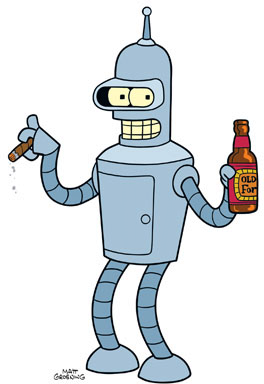How do we model this robot?
Automata Theory and Complexity Theory model what machines can compute, but these models say little about what machines are actually capable of doing. Let's call the things a machine can compute its Computational Ability and the things a machine can do its Informational Ability. An analogy to robots will make the difference clear.
Robots of two kinds
There is a robot. The robot is humanoid. It has arms and legs with motors so that it can move around, and a camera sensor to "see." This robot exists in a universe where true Turing Machines can actually be built. However, the robot comes with no computer. It is up to the owner to install one. Fresh out of the robot factory, the robot has an empty socket with some pins wired up to its motors and camera.

Figure 1: Bender Bending Rodriguez
Let's install a finite state machine into the robot. We will give the state machine connections to the robot's camera and motors, so that it gets the camera feed as its input stream and can send signals to move by entering special states. Our robot's brain is finite-state, so it will not be good at doing math (after the equations reach a certain size, it won't even be able to keep its parentheses balanced), but nevertheless it can make some rudimentary observations about the world and can move around. It happens to be made of titanium, and the motors are pretty powerful, so it's wise to keep our distance.

Figure 2: Deep Thought
Now let's do something different. Instead of giving the robot a finite-state brain, we will give it a Turing Machine brain. The robot is excited at the prospect of being able to do math, but it will be disappointed because we have done something truly evil. All of the pins that ordinarily would connect the Turing Machine to the motors and camera have been disconnected. The Turing Machine fits snugly into the socket, but no matter how hard it tries it cannot put any voltage onto the pins. The robot's brain can simulate a clone of the entire universe, wherein the simulated copy of itself can move, but there is no way the Turing Machine will ever get the robot to move in the real world.
The Finite State Robot is a machine with low Computational Ability but high Informational Ability. It's bad at computing, but it has all the tools it needs to observe and affect the state of things beyond itself. The Turing Machine Robot has high Computational Ability but zero Informational Ability. It can compute any computable function, yet it cannot learn a single bit about the real world, nor can it meaningfully change the outside world (so long as nobody opens it up and observes its state).
"Informational Ability" is so named because it seems to be the ability for information to cross boundaries. When the finite state machine is looking at the robot's camera, information is flowing from outside in. When the finite state machine is moving the robot's arms, information is flowing from the inside to the out.
The two notions of ability are orthogonal but tightly intertwined. Only after both types of capability have been specified can we begin to predict what the robot will do. If we only know the Informational Ability, we may know that it controls enough hardware to kill a human, but without knowing the Computational Ability, can we find out if it has motive to kill? Given the Computational Ability we can put bounds on the robot's intelligence, but without knowing the Informational Ability we are not sure if we should even care about its intelligence. Both notions seem to be equally important in determining the robot's behavior.
Should we fear the robot?
So far we have been talking about robots, but this is really about computer security. What is the Computational Ability and Informational Ability of, say, a JPEG image being viewed in a web browser? To find the answer to "Can a maliciously crafted JPEG read the user's email?" we need to know both the Computational Ability and Informational Ability of the pairing of a JPEG file with the web browser.

Figure 3: The Chomsky Hierarchy
We have great models of Computational Ability. Studying DFAs, NFAs, NPDAs, Context-Free Grammars, and Turing Machines has given us a clear sense of which functions can be computed by the different types of machines. Complexity theory even aims to tell us how long it takes to compute a function.
On the other side, our models of Informational Ability really suck. All we have are simplistic black-and-white access control models. Access is divided into two or three types (read, write, execute), and permissions are either "yes", "no", or "temporarily." To see how these models fall short of being a theory for Informational Ability, consider the example of a cache-timing covert channel between processes. How do we model that? Surely access control is "broken." But how broken is it, and why is it broken? The covert channel is just a counterexample to the hypothesis that the access control mechanism is secure, and nothing more. We can come up with ad-hoc ways to quantify the attack, like measuring the channel's maximum bit rate, but if we have to come up with new ad-hoc measures for every class of attack, we don't really have a theory.
To understand security, we need good formal models of both Computational Ability and Informational Ability. LangSec is making headway applying Computational Ability models to security, but we are still far from a workable model of Informational Ability.
Informational Ability is not a topic in the field of computer security. Rather, it is a fundamental unsolved problem of computer science. I do not expect it to be easily solved (try defining a "boundary" for "information" to "cross"), but the lack of a model is a clear problem. Now that we know what we are missing, we can start looking.Image credit: Chomsky hierarchy image by J. Finkelstein, CC-BY-SA. Bender image from a Comedy Central promotional release, and Deep Thought image from Touchstone Pictures (via The Guardian).


